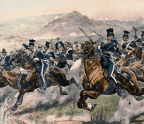
A thens invaded Sicily in 415 BC with soaring hopes and bold—albeit ill-defined—ambitions. Two years later the tattered remnant of its army was in full retreat, desperately seeking respite from the enemy it had intended to conquer. Bloodied, fearful, starving and plagued by continual assaults that thinned their ranks and destroyed their morale, the exhausted troops fled onward. There was no longer any thought of victory—only escape.
Harried by enemy cavalry, the Athenians sought refuge in the southern part of the island. With ebbing strength, few provisions and little water, they rushed to the Assinarus River, both to quench their desperate thirst and in hopes of crossing it to safety. There they found death rather than deliverance.
All order was lost as they reached the river. Plunging into the water, many struggled to be first across, while others drank greedily. Little did they know their crafty enemy lay in wait on the opposite bank. Attacked from the front and behind, scores died on the points of javelins or entangled themselves hopelessly with the baggage, stumbled and drowned. Surging down both banks, the enemy butchered many others with swords, fouling the water with gore even as desperate fellow Athenians continued to drink.
The most glorious Hellenic expedition undertaken during the 431–404 BC Peloponnesian War perished there in bloody mud. Its generals were executed. Any who escaped the slaughter were condemned to toil and misery in Sicilian stone quarries or sold into slavery. The disaster was so devastating and so complete that Athens could scarcely believe it had happened.
To fully understand the reckless daring of Athens’ invasion of Sicily, one must examine it in context, assessing its risks, murky motivations, dubious goals and problematic execution.
The backdrop to the Athenian invasion of Sicily is the Peloponnesian War. Six years into an armistice with Sparta, which had suspended open hostilities, the




